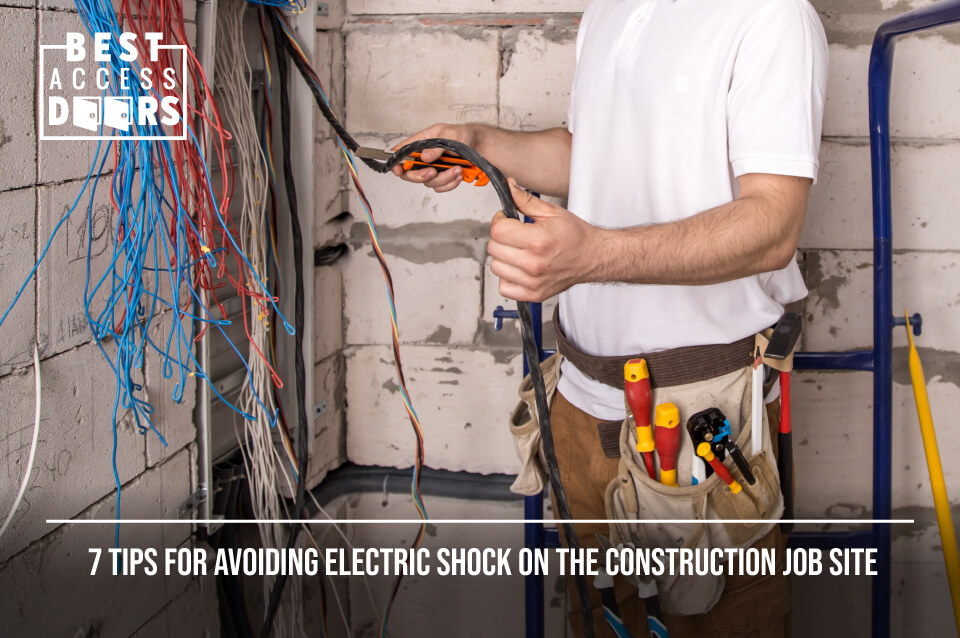7 Tips for Avoiding Electric Shock on the Construction Job Site
Posted by Best Access Doors on 23rd Aug 2023
Electric shock injuries and fatalities are significant concerns on construction sites. They often arise from high-voltage sources, damaged equipment, harsh conditions, and insufficient safety practices. A momentary lapse in safety checks can lead to devastating consequences, affecting the worker, their family, and the company with financial and legal repercussions.
This article provides a straightforward framework of seven essential safety tips for construction supervisors, safety managers, and workers. It highlights the importance of secure access doors to protect exposed electrical components and wiring.
Important Training and Certifications
Electrical safety starts with knowledge. OSHA mandates that employees at risk of electrical hazards receive thorough training on finding and avoiding unsafe conditions.
For construction workers, the OSHA 10-Hour course is essential for entry-level workers, while the 30-Hour course targets supervisors and managers. These courses cover critical topics like proper grounding, safe use of GFCIs, and lockout/tagout procedures. Prioritizing this training fosters a culture of safety and accountability on the job site.
Tip 1: Know Your Site and Reduce Your Risks
Accidents on the job site can have serious consequences, especially with electrical hazards. Before starting work, it's essential to familiarize yourself with the site to prevent electrocution.
Begin by walking through the area to find potential hazards, such as temporary power sources and extension cords. Pay special attention to overhead power lines and buried cables, which are often overlooked. Collaborate with your local utility company to mark underground lines accurately.
After assessing the risks, create a safety plan that includes marking dangerous areas with warning signs and barriers. Share this plan with your team and educate them about the risks to ensure their safety and well-being.
Tip 2: Ensure Ground-Fault Protection for Safety
Ground-fault protection is vital for preventing electrical injuries. A Ground-Fault Circuit Interrupter (GFCI) can save lives by cutting off power when it detects an imbalance, showing a ground fault. This quick response occurs in a fraction of a second, helping to prevent electrocution. Regularly test your GFCIs to ensure they function properly, creating a safer work environment for you and your team. Stay alert and safe.
Tip 3: Check Your Gear Before Each Use
Inspecting your gear before use is essential to avoid electric-related injuries. Look for damaged cords, tools, or equipment—frayed wires, cracked insulation, or broken plugs can show issues. If you find anything faulty, tag it or remove it at once.
Avoid using tools in ways they weren't designed for, and never alter cords or equipment, as this increases the risk of injury. Make inspections a routine part of your work to ensure everyone’s safety and keep a secure environment.
Tip 4: Lock It Out, Tag It Out
Lockout/Tagout (LOTO) procedures are important for safety during maintenance. Using a LOTO device prevents accidental startup by securely locking the power source and keeping the circuit off while you work. Without proper LOTO, a coworker might mistakenly turn on the power, posing a serious risk of injury.
Always follow your company’s LOTO policy. Before starting work, verify that the power is turned off to minimize electrical hazards.
Tip 5: Always Respect Power Lines, Both Above and Below
Power lines are dangerous and can cause fatal shocks. Maintain a safe distance from overhead lines to avoid accidental contact with tall equipment. Always treat every line as live and report any digging to the utility company to check for the locations of underground cables. Keep ladders and scaffolding away from power lines to ensure safety for yourself and your team.
Tip 6: Dress for Safety
Personal protective equipment (PPE) is your last defense against electrical hazards. While it should never replace other safety measures, it remains a critical barrier against electric shock. Ensure that you and your team use the proper PPE:
- Insulated gloves protect your hands from live wires.
- Non-conductive footwear helps prevent dangerous electrical currents from passing through your body to the ground.
- Safety goggles shield your eyes from an electrical arc flash's intense light and heat.
Make sure all PPE is well-maintained. Before each use, check for cracks, tears, or worn-out spots. Never work without the proper gear—your safety depends on it.
Tip 7: Improve Safety with the Right Access Doors for Your Wires
Open areas with electrical wiring can be risky for everyone on-site. Installing access doors and panels can help manage these hazards and enhance safety.
Choose the right door based on specific needs: use a Fire Rated Access Door for compliance, a Recessed Valve Box to conceal valves and electrical systems, a Plastic Access Door for simpler needs, or a Drywall Access Door for a clean look.
A Practical Solution for an Urgent Problem
Electrical safety requires everyone’s commitment. This guide outlines strategies to protect lives and create a safe working environment for everyone on site. We must not wait for an accident; the risks are too high. We need to act now.
By working with Best Access Doors, you can protect your workers from electrical hazards, follow safety regulations, and reduce liability risks. It is essential to act today for a safer tomorrow.
Don’t wait—take the next step to secure your job site. Call +1-888-327-5471 now to speak with our experts and explore our catalog of essential access solutions. Your team’s safety depends on it!
Share our story - the 2025 version is available

